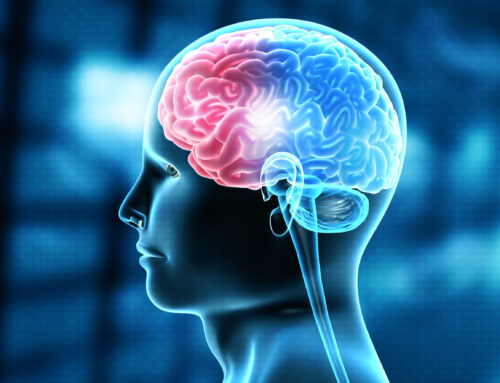Fibromyalgia
Fibromyalgia is a chronic pain condition, hallmarked by widespread pain for greater than six months, combined with possible combination of cognitive dysfunction, IBS or other gastrointestinal involvement, and fatigue or sleep disturbances. It is no surprise after hearing that list of symptoms that many patients dealing with this condition are also dealing with feelings of stress, deterioration of mental and physical health, and feelings of social isolation.
The cause of fibromyalgia is not fully understood, but the main aspect is nervous system sensitization(5). Simply put, this means that a history of injury, physical trauma, or a fear of these events have put the body into high alert for these to occur again. Since pain is the body’s way of telling the brain about danger, this phenomenon is presumably the body’s way of saying: “Hey, you don’t seem to be getting the message that we’re in danger here, so let me scream louder.” An attempt to be helpful that does not end up being very helpful.
There is a high degree of stress and frustration for fibromyalgia patients, due in part to the difficulty in getting a diagnosis and the lack of evidence on treatment paths. Because fibromyalgia is a diagnosis of exclusion, with no diagnostic tests available, it can take a long time to receive a diagnosis. In addition, there are no standards of practice to guide practitioners and patients often react differently to treatments, which makes implementing standards of practice difficult.
Personally, I believe that with more research and understanding, we will find that fibromyalgia is a category of conditions, rather than a single diagnosis, however it will likely be a long time before this theory is proven, or disproven, by science.
What we currently know about fibromyalgia is that there is a strong correlation with mental health conditions. This is likely due to events prior to developing fibromyalgia symptoms, since there is often a history of traumatizing injury and/or abuse in people with fibromyalgia, as well as events after developing fibromyalgia symptoms, since fibromyalgia is one of the most debilitating chronic pain conditions(2) and fibromyalgia patients are often type A go-getters(1), the combination of which is very difficult to deal with.
Goal setting for treatment is, of course, done by the patients, but from a practitioner perspective, the two main goals are to improve pain symptoms and improve sleep quality, and doing so by soothing the dysregulated nervous system. My personal favourite way of doing this is through mindfulness-based training(4), however cognitive behavioural therapy(3) and certain antidepressant medications(3) are both well researched in this area.
As with most chronic conditions, a multidisciplinary approach is best to help deal with fibromyalgia. As a Naturopath, my treatment plans for fibromyalgia often include mindfulness, exercise, correcting nutritional deficiencies and eliminating food triggers, working on sleep hygiene, and adaptogenic herbs that are known to improve the body’s ability to tolerate stress.
This blog was written by Dr. Crysana Copland, Naturopathic Doctor at Brant Mental Health Solutions. For more information or to book a free consult, call us at 519.302.2300 or email reception@brantmentalhealth.
-
Galvez-Sánchez, C.M., Duschek, S., & Reyes del Paso, G.A. (2019). Psychological impact of fibromyalgia: Current perspectives. Psychology Research and Behavior Management, Volume 12, 117–127. https://doi.org/10.2147/prbm.
s178240 -
Verbunt, J.A., Pernot, D.H. & Smeets, R.J. Disability and quality of life in patients with fibromyalgia. Health Qual Life Outcomes 6, 8 (2008). https://doi.org/10.1186/1477-
7525-6-8 -
Clauw DJ. Fibromyalgia: a clinical review. JAMA. 2014 Apr 16;311(15):1547-55. doi: 10.1001/jama.2014.3266. PMID: 24737367.
-
Adler-Neal, A. L., & Zeidan, F. (2017). Mindfulness meditation for fibromyalgia: Mechanistic and clinical considerations. Current Rheumatology Reports, 19(9). https://doi.org/10.1007/
s11926-017-0686-0 -
Clauw DJ. Fibromyalgia and related conditions. Mayo Clin Proc. 2015 May;90(5):680-92. doi: 10.1016/j.mayocp.2015.03.014. PMID: 25939940.













 Sharon Walker, MSW, RSW
Sharon Walker, MSW, RSW Jordon Iorio Hons. BA, RSW
Jordon Iorio Hons. BA, RSW Christine Bibby, B.S.W., M.S.W., R.S.W.
Christine Bibby, B.S.W., M.S.W., R.S.W. Brianna Kerr, RSW
Brianna Kerr, RSW Danielle Vanderpost, RSW
Danielle Vanderpost, RSW Daniela Switzer, MA, C.PSYCH
Daniela Switzer, MA, C.PSYCH Tammy Adams
Tammy Adams Jade Bates, RMT
Jade Bates, RMT Caitlin Schneider
Caitlin Schneider Dr. Crysana Copland
Dr. Crysana Copland
 Amy Dougley
Amy Dougley Emily Green
Emily Green Bill Dungey, RSW
Bill Dungey, RSW



 Jessica Moore, RSW
Jessica Moore, RSW Abigail Wragge, RSW
Abigail Wragge, RSW